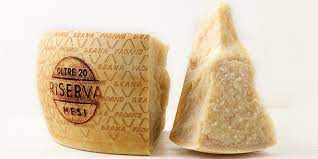Grana is a class of hard, grating cheese from Italy which was developed in the 13th century in the Po Valley. One-quarter of Italian milk production is used on Grana cheese. There are several varieties of this cheese, Grana Padano being just one. Most of the cheeses are aged for up to four years. The name comes from the noun grana (‘grain’), which refers to the distinctive grainy texture of the cheese, and the Padano, which refers to the river Po valley. Grana Padano was created by the Cistercian monks of Chiaravalle in Northern Italy. They used ripened cheese as a way of preserving extra milk and by the year 1477, it was regarded as one of the most famous cheeses of Italy. Today, this product is made in the regions of Piedmont, Lombardy and Veneto, and in the province of Trento. Production and quality are now overseen by the Consorzio per la Tutela del Formaggio Grana Padano
Like Parmigiano Reggiano, Grana Padano is a semi-fat hard cheese which is cooked and ripened slowly (for up to 18 months). It is produced by curdling the milk of grass-fed cows. The cows are milked twice a day, the milk is left to stand, and then partially creamed. It is produced all year round and the quality can vary seasonally as well as by year.
A wheel of Grana Padano is cylindrical, with slightly convex sides and flat faces. It measures 35 to 45 cm in diameter, and 15 to 18 cm in height. It weighs 24 to 40kg. The rind, which is thin, is white or straw yellow.
